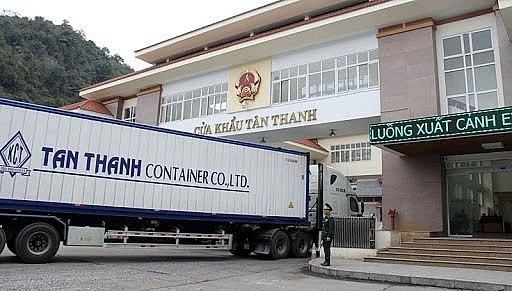 |
|
Tan Thanh is one of the auxiliary border gates in the northern province of Lang Son. Photo: VNA
|
The Ministry of Industry and Trade (MoIT) recently proposed to the prime minister to permit customs goods clearance across all secondary border gates in the northern province of Lang Son on the Chinese border.
The goal of the move is to improve volumes of import and export goods between the two countries, currently only hitting around 50-60 per cent of pre-pandemic numbers.
Lang Son alone boasts 10 secondary border gates. Two of them, Tan Thanh and Coc Nam, were reopened recently as China tries to pull itself out of the COVID-19 mire.
According to the ministry, current clearance capacity at Tan Thanh is exceedingly limited, with only up to 150 trucks moving goods to China, accounting for half of the goods set for export on a daily basis. Remaining items are stored at the border gate.
Lang Son, along with China’s Guangxi Zhuang autonomous region, has agreed to ensure the required conditions to help restore clearance of goods at the border, involving strict utilisation of disease prevention procedures.
The MoIT added that China’s control of the pandemic has improved recently, demonstrated by Yunnan and Guangxi Zhuang autonomous region lowering the emergency response level from one to three. These two provinces have been partially restoring trade between residents of the two sides to meet the increasing production and consumption demands.
This attempt to reopen borders, especially with Vietnam, is part of a wider effort by China to jump-start its economy. It is a huge juggling act – determining the correct amount of time to ensure lockdowns, while increasing economic activity in a way that does not trigger a second wave of coronavirus infections across the country.
Nevertheless, China’s moves will provide clues for other countries. The crisis may have started there, but simply through that fact, China may be best placed to gain in the long term as nations worldwide attempt to recover economically.
What were initially seen by many as drastic measures by China are now being viewed as perfectly sensible in trying to control the virus. Now, locally-transmitted cases have plummeted, and a shutdown of most of Hubei province, where the pandemic originated, was lifted last week.
But the lockdown also halted activity for around two months, likely to result in China’s first contraction in decades. Goldman Sachs analysts have predicted that the country’s GDP may fall by 9 per cent for the first quarter of 2020 compared to the same period last year.
The Chinese government understood that its actions to contain the virus came at the expense of economic health, just as the Vietnamese government’s timely moves illustrated in this country.
The task now is for leaders to figure out how to dampen the consequences and get working again, which will have knock-on effects for the rest of the world but particularly bordering nations.
Chen Xingdong, chief China economist for BNP Paribas told CNN, “The economic losses have become intolerable,” adding that the government has to balance resuming work while remaining vigilant. “I don’t think it is right to restart business and production only when the virus has totally disappeared.”
Learning from others
Vietnam and China hold a colourful history together, and have strived to build a successful trade relationship over the years. It only took a few years after Vietnam introduced the Law on Foreign Investment in 1987 for their northern neighbour to begin seriously looking at pumping money in the country. Funding was relatively limited in the 1990s, but saw a significant increase after China joined the World Trade Organization in 2001, with a main focus on real estate, agriculture, and labour-intensive manufacturing.
In Vietnam, local producers over the years have depended on exported materials from across the border but amid warnings that depending on one other market is risky, and with Vietnam’s increasing stature among other economies in the form of free trade agreements, the country has forged its own image as a safe and profitable destination for investment.
Yet, similarities of course remain when it comes to fighting against a common enemy in the coronavirus.
China’s economic solutions rest on policies and campaigns attempting to get people back to work, while encouraging business confidence both at home and abroad, protecting as many companies from failing as possible. Many countries after China will strive for the same and while Vietnam is currently tightening movement of people within their daily lives, it is likely the country will follow suit with policies akin to China, especially if they work.
But these actions might only provide so much help for Western markets that are less-centralised in control.
“The Chinese are resuming some large infrastructure projects which are largely funded by the state,” said Xiaobo Lü, a professor of political science at Columbia University, adding that industries served by those ventures are fairly simple to kick-start, and can absorb idle labour.
“While it’s true the crisis isn’t over for China, lessons can be learned from it,” said Helge Berger, the International Monetary Fund’s assistant director of Asia-Pacific. “China is also demonstrating importance that policymakers have to be ready for what is an unavoidable slowdown in growth. The economic fallout from the virus is going to be severe. This is meaningful and requires our attention.”
Future winners
In fact, despite suffering first, the country could ultimately benefit and move ahead on the global economic chessboard, outmanoeuvring the United States. Europe is also watching on, and in a few months could find itself in the middle of a tug-of-war between the world’s two biggest superpowers.
“The Chinese are in a much stronger position than they have been coming out of any recent global crisis,” Ian Bremmer, president and founder of Eurasia Group, told MarketWatch. “China owns most of the global medical supply chain, and they’ve leveraged this containment success by providing aid to Europe and emerging markets.”
Carl Weinberg, founder and chief economist at High Frequency Economics, said in one interview Chinese leaders simply seem to have a better handle of the issue. “The Chinese built a hospital with 2,000 beds in 10 days from start to finish,” he said. “This happened in January before the pandemic was fully recognised. The US is way behind the curve on this.”
Increased tensions could result in further dents in the already-fractious US-China economic relationship. This may not only help continue the acceleration of businesses relocating to regional countries, but also push Europe into the arms of China.
“The pandemic is going to reinforce that the US is simply not the highly functional, advanced role model it used to be,” said Edward Alden, senior fellow at the Council on Foreign Relations, a US think tank specialising in America’s foreign affairs. “The Europeans have, in the past, looked at the US with a fair degree of awe, because of its innovative companies, strong university system, and the ability to attract highly skilled immigrants.”
Now, Alden warned, the US is on a course to suffer a worse outbreak than Italy.
The consequences for a Chinese revival, and the US not sufficiently dealing with COVID-19, could be deep for American businesses, according to Eurasia Group’s Bremmer.
“This will accelerate the de-globalisation trend in data and manufacturing, and it means that the Europeans are less likely to follow the US on some issues,” Bremner said, explaining that it also increases the ability of China to happily continue with its ambitious global development strategy initiatives.
Meanwhile, for Vietnam, it may be a waiting game to capitalise on global movements, but the country was already seemingly on the right track as the US-China trade dispute unfolded.
“Global companies have been testing Vietnam’s capabilities for several years —even before the added impetus from the US-China trade wars,” explained Min Zhou and Vivian Chen, research analysts at global asset management firm AllianceBernstein, in a recent report. “Labour costs in Vietnam, with its younger workforce and ample supply, are about 40 per cent lower than in China. Many popular clothing and sportswear brands, including Nike and Adidas, already have a large manufacturing presence in Vietnam.”
The key for Vietnamese plants is to meet the strict standards of these major companies, and Zhou and Chen’s report found that, in general, managers are taking a “step-by-step” approach by introducing simpler product lines before moving onto more complex items. “Risks in this area are unlikely to stop the shift. If anything, the coronavirus crisis will accelerate moves by global companies into Vietnam,” the report added. VIR
Quang Bao

Will phone exports bounce back as Samsung’s production in China slows?
Samsung is believed to have great advantages over its rivals as its production base is in Vietnam, not in China, where the Covid-2019 has forced a series of factories to close down.

COVID-19 outbreak to accelerate relocation wave from China to Vietnam
While COVID-19 will have a negative impact on Vietnam's economic growth in 2020, it will boost the relocation of manufacturing facilities from China to Vietnam.
 China is beginning to offer a glimpse into the near future for some countries, as the economic superpower tries to pick itself back up slowly following major lockdowns in the wake of the coronavirus crisis.
China is beginning to offer a glimpse into the near future for some countries, as the economic superpower tries to pick itself back up slowly following major lockdowns in the wake of the coronavirus crisis.